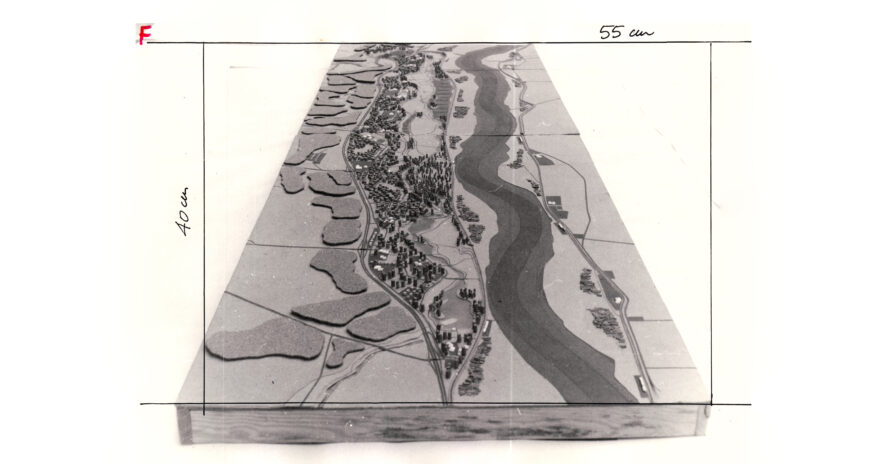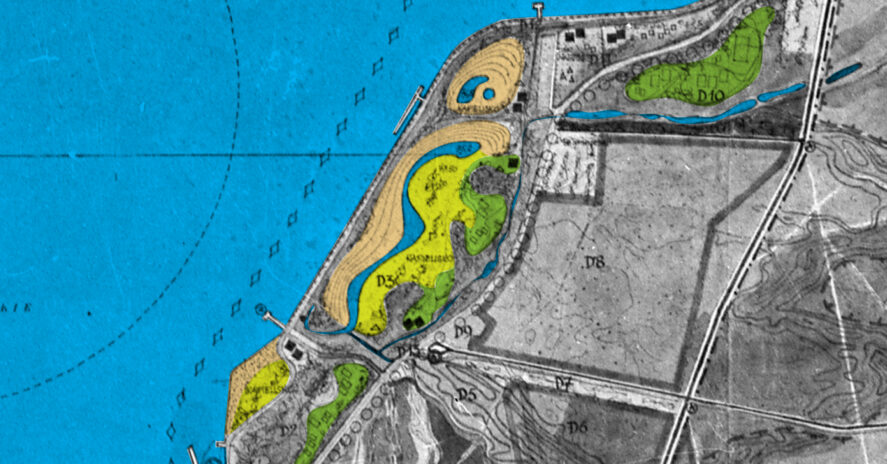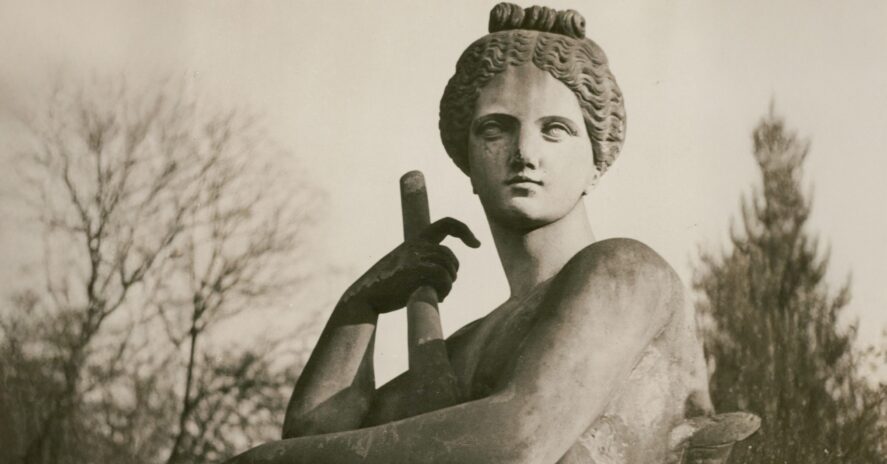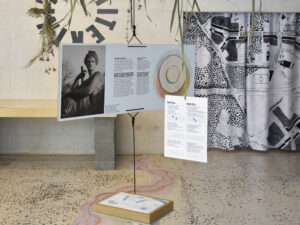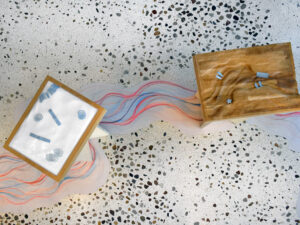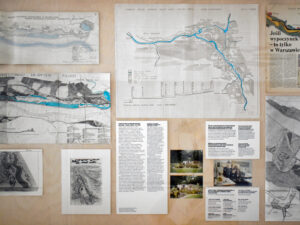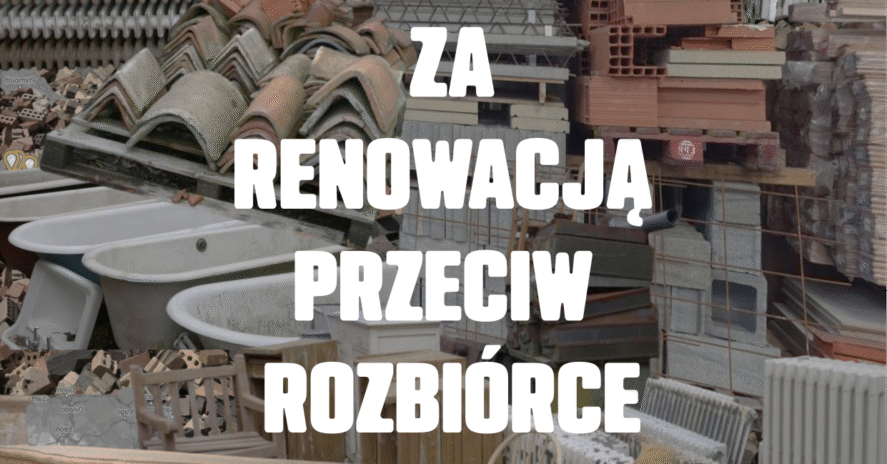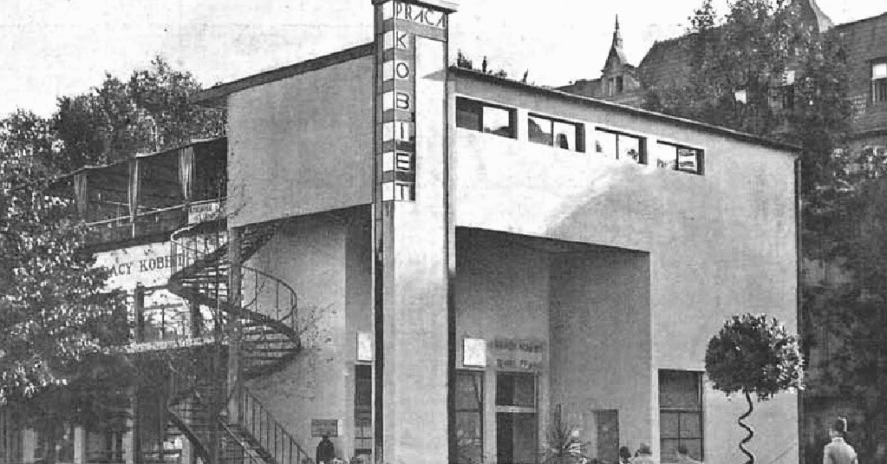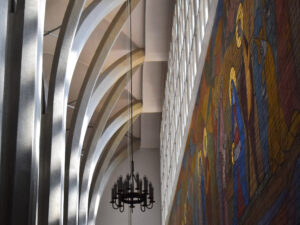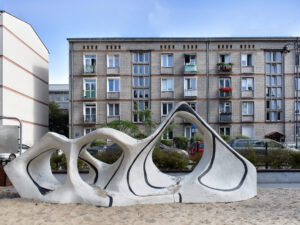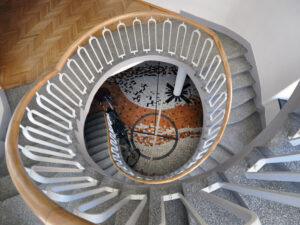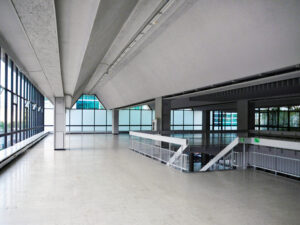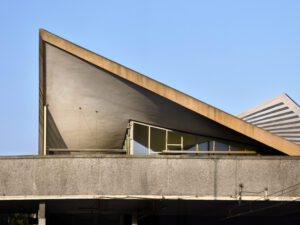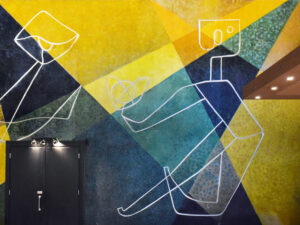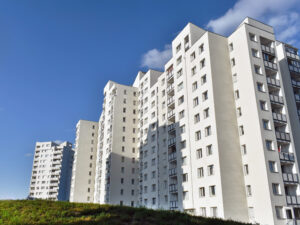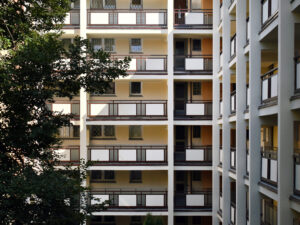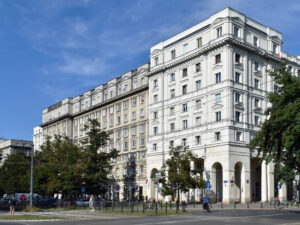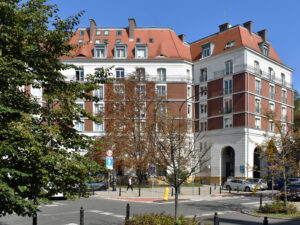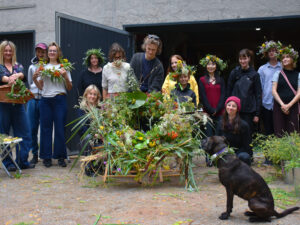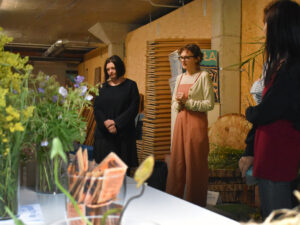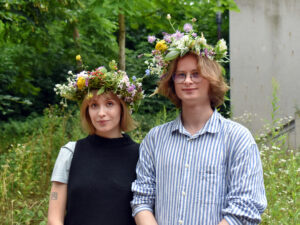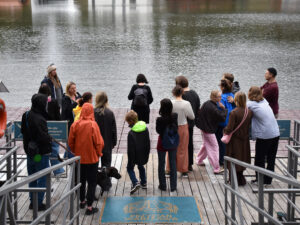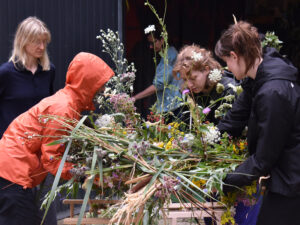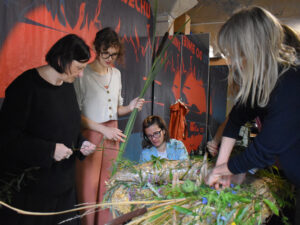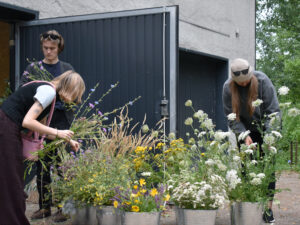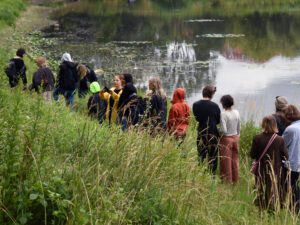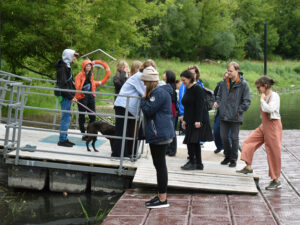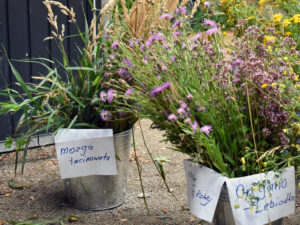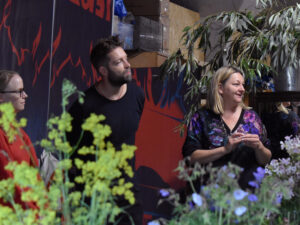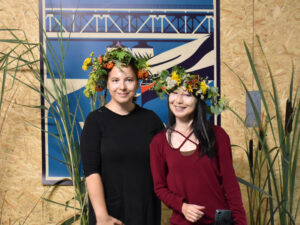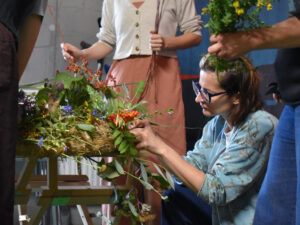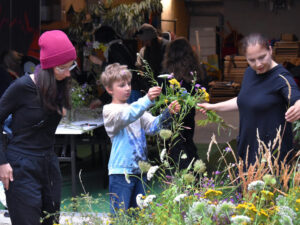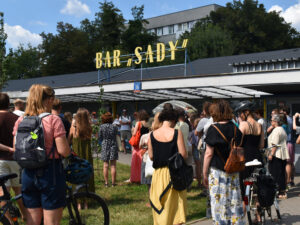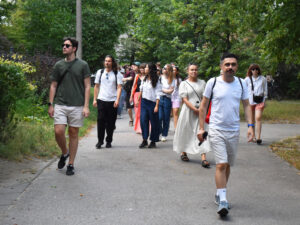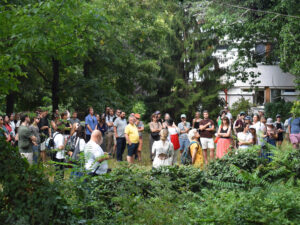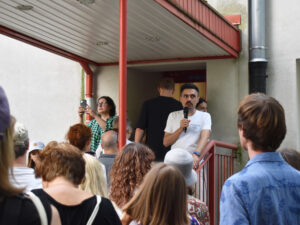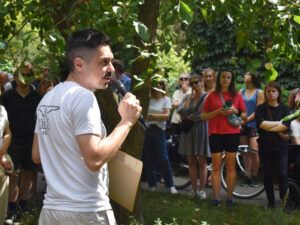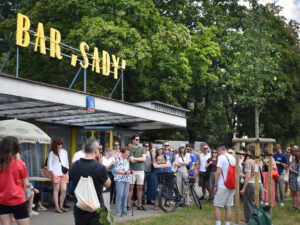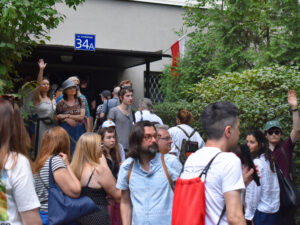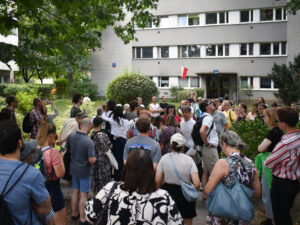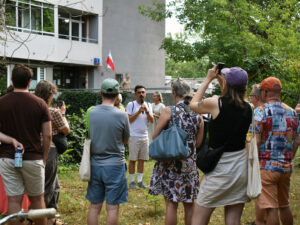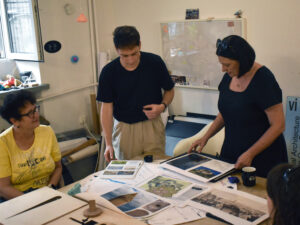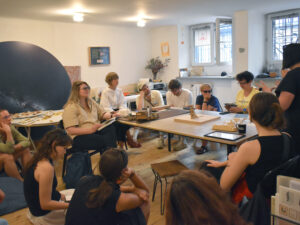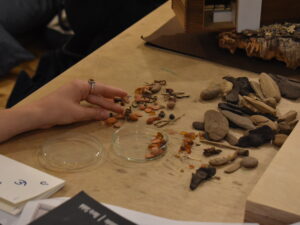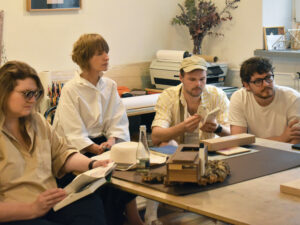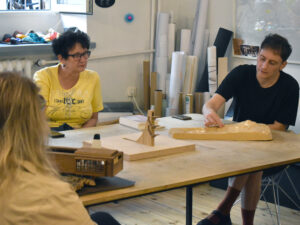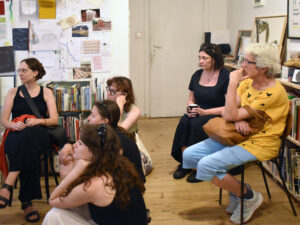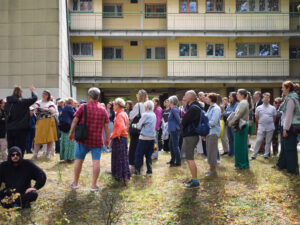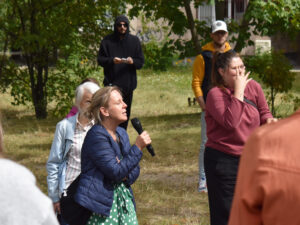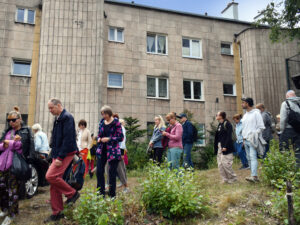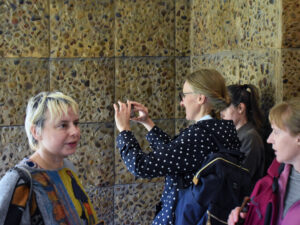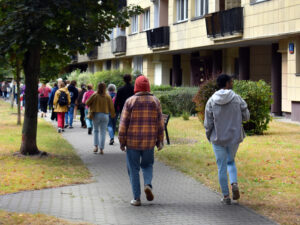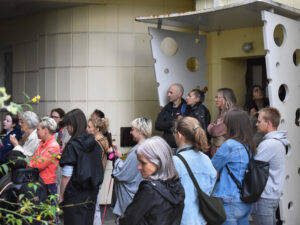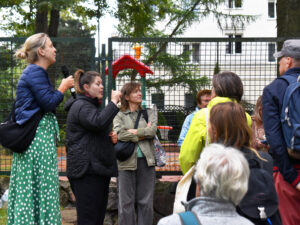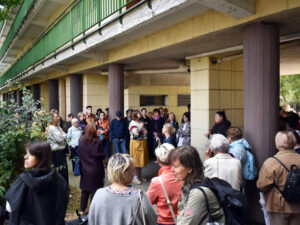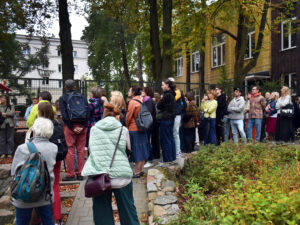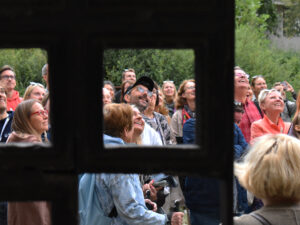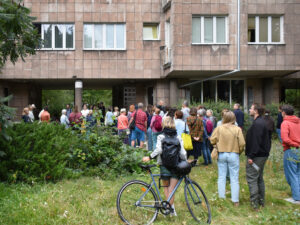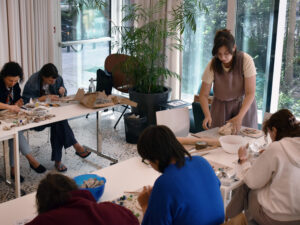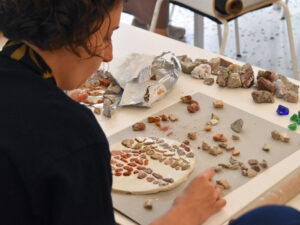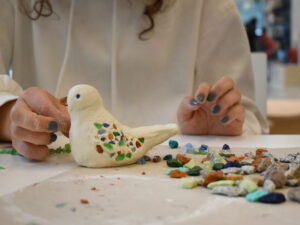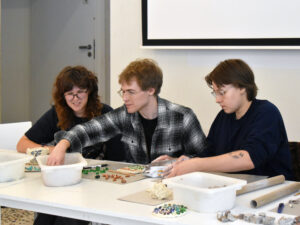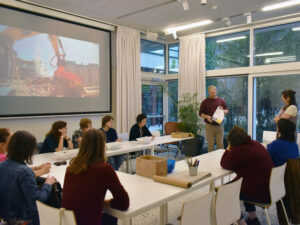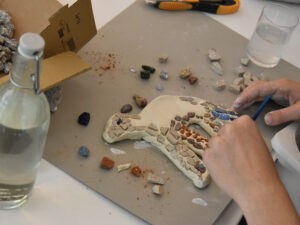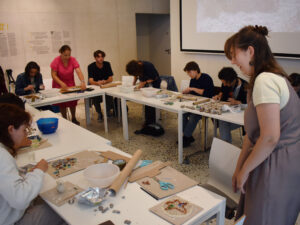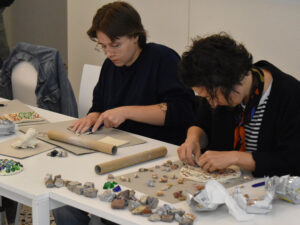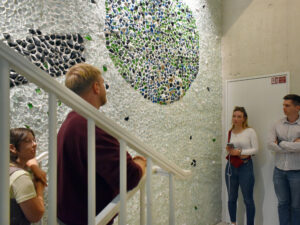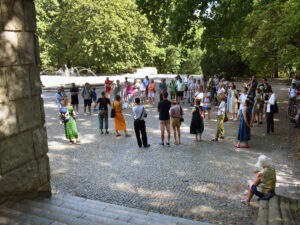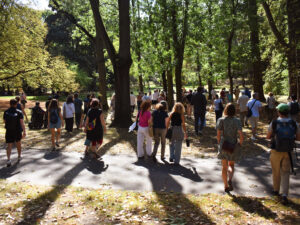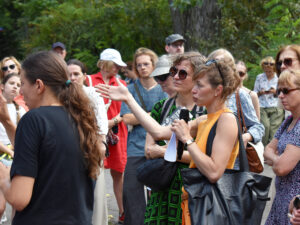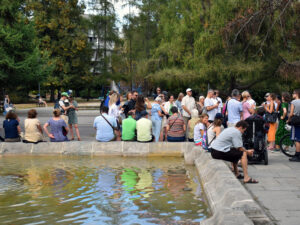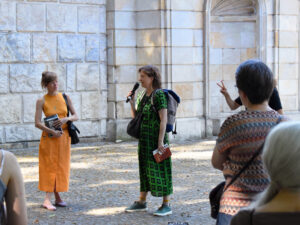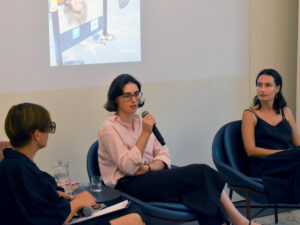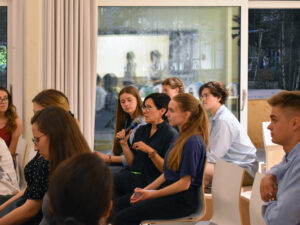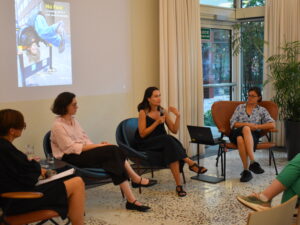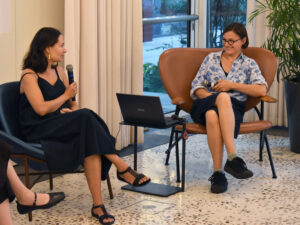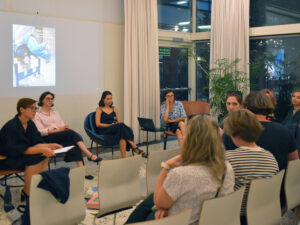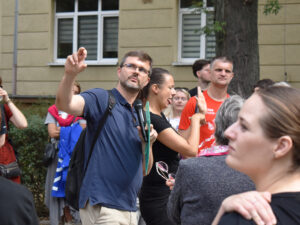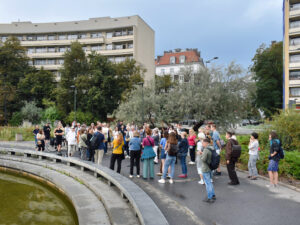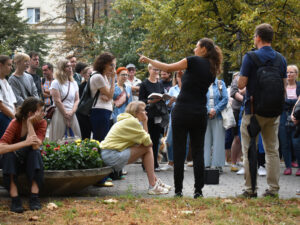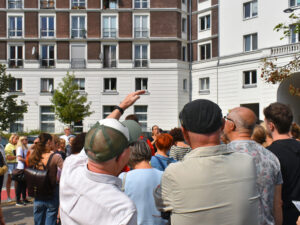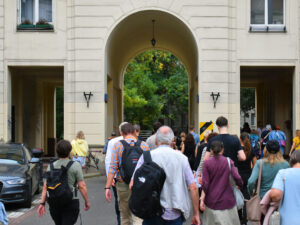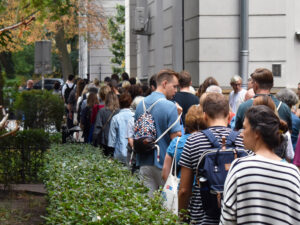ARCHITEKTKI
Architektki* is a project where the past meets the future. It’s a story about women who, by designing the world around us, influence how we perceive it.
*Architektki (pronounced: [arxiˈtɛktki]) stands for women architects in Polish.
Five duos, consisting of renowned Warsaw architects and five creators from the younger generation, created works interpreting the achievements of selected designers from earlier generations.
Do gender and location determine how we perceive the space around us? Is there a certain intergenerational continuity in the work of female architects working in our city?
The exhibition is about sharing knowledge, experience, and caring for space and the environment. This idea also guided the design and production of the exhibition, which was created almost entirely from recycled materials.
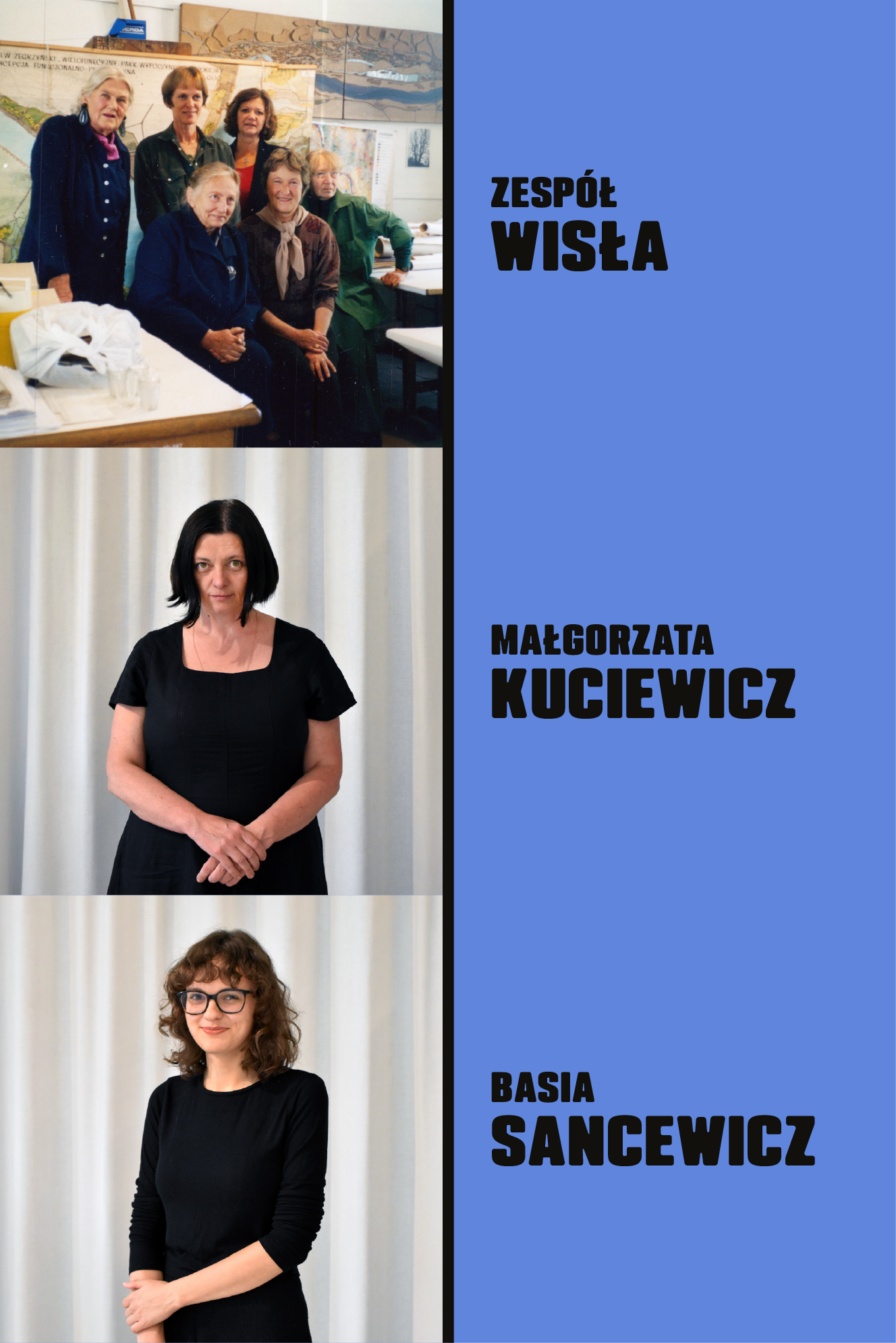
The Vistula river bears a female name. For centuries we have seen her as a symbol of life, strength and care, as a woman, a queen, a protector. But she is of dual nature: she gives support, she is ever-present, enduring but also unruly, changeable and anything but submissive. Perhaps it is in its unsteadiness – its tides, its backflows, its cyclical processes – that its true beauty lies?
TEAM WISŁA
Team “Wisła” worked, among other projects, on the development of the Vistula Valley along the entire Warsaw agglomeration in an area of 170 km – from the mouth of the Wilga River to the mouth of the Bzura River. The planners saw a major role for water in shaping the recreational programme and were guided by the rationale of protecting landscape resources. They emphasised the need for the projects to fit into the riverside landscape. In 1973, the team was awarded the first-degree prize by the Minister of Administration, Land Management and Environmental Protection.
THE VISTULA CALENDAR
River time does not flow linearly, only forward – it has reversals, longer stoppages, momentary suspensions and accelerations. This is how it has worked for centuries, regardless of our presence. Water time is the cyclical nature of hydrological processes. It requires one to notice the river as a living organism, teeming with the rhythm of seasonal highs and lows, sediment migration, changes in temperature, vegetation growth and die-off. Instead of trying to control these dynamics, we should begin to understand them. The variability of the river gives it strength and balance. The Vistula teaches us to feel our own rhythms, which were once close to us but which we have stopped perceiving. Our time, like her, is cyclical.
THE VISTULA CURRENT
The waters of the Vistula river do not flow straight and at a uniform pace, nor do they move along the shortest path. Beneath its seemingly homogeneous surface, the river is volatile. It has its own hydrology and even in a straight section it flows with spiral and helical movements. This circulation is modified by the configuration of the river bed and the concentration or spreading of the current.
The Vistula river changes with the rhythm of tides and droughts, can be compact or stretched out, and periodically spills out. The moving current sculpts sandy outcrops, islands and shoals, the faster current snatches up ‘rises and drags’, depositing them when it weakens. New structures comb the current into trickles.
The surface is never dead, it is always vibrating. In places it is smooth and dull, elsewhere it is full of reflections or wrinkled with seeding. From the small undulations, from the streaks, from the changes in the reflections, from the turbulence, we can read how the currents have re-arranged themselves, what the bottom and the flow look like. Every year we can learn about the dynamics of the Vistula’s waters.
THE GARLAND – THE RITUAL OF THE GIFT
Our relationship with Vistula was rarely based on reciprocity. In literature – a queen, a protector, and a mother. And in reality – a polluted, sickly servant. We draw energy and cooling water from her, and we return the favour by dumping sewage or imposing a concrete corset in the form of trough regulation. Is this how we should treat someone who gives us so much?
RITUALS IN THE OPEN WATER
Recreation is not only fun but also renewal – the Latin word recreatio means healing. For centuries, we have sought it by the water. In the past, this need for contact was embodied in rituals: throwing garlands, washing the body, bathing in the depths. But on a physical level, ritual is simply movement – repetitive, cyclical. Present both in man and in the river.
Today’s coastal infrastructure mostly ignores this rhythm. It is rigid, designed as if it were to survive even the river itself. We are still separated from the Vistula river by a wall – not only of concrete – sometimes of the habit of thinking that water is an element to be feared.
This is how a series of contemporary rituals was created – conceptual coastal objects inspired by the archetypes of waterfront infrastructure. But transformed so that they do not change the river but learn its rhythm.
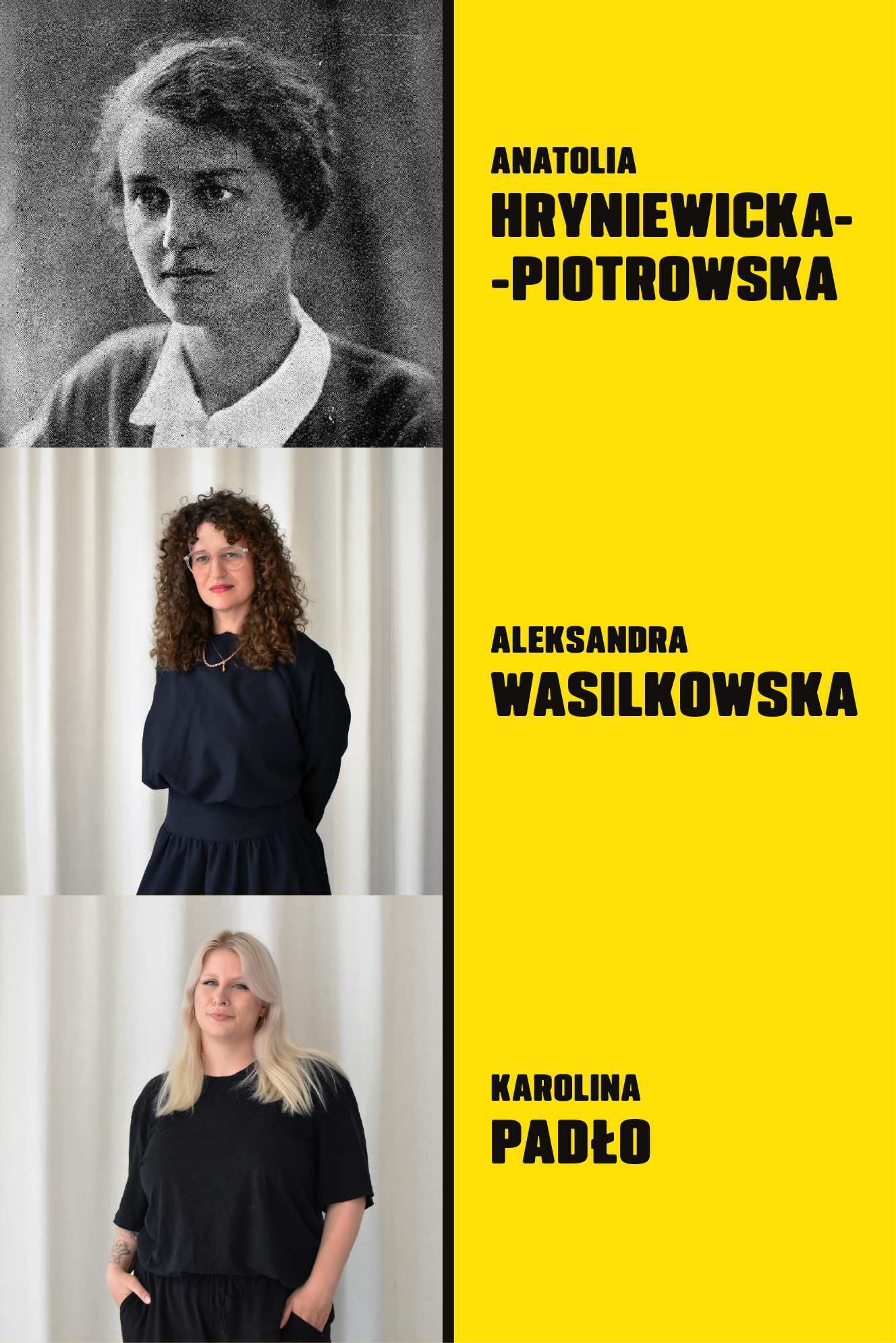
We dedicate our project to Anatolia Hryniewicka-Piotrowska, who belonged to the pioneering generation of women in Polish architecture and was the author of the design of the Women’s Work Pavilion. In 1929, the Pavilion hosted an unprecedented exhibition showing a new perspective of women’s lives and work, as well as the difficulties and barriers women faced on their professional paths in the fields of art, science, politics, sport, crafts and agriculture.
Nearly a century later, despite blazed trails and open doors to universities, the independent practice of female architects still faces many barriers and difficulties. Women’s work in architecture remains overshadowed by men. We see our participation in the exhibition and the petition as a continuation of the efforts of our predecessor. In a symbolic way, we are adding another chapter to the exhibition at the Women’s Work Pavilion, related to the pro-social and pro-environmental role that female architects can play for a more environmentally-saving and socially-just architecture.
FOR RENOVATION, AGAINST DEMOLITION
„Demolitions cause enormous losses of homes, jobs, energy, and memories.” – HouseEurope!
By 2050, 70,000 buildings will have been demolished in Poland and more than 1.5 billion square metres of space will have been wasted across Europe. This amount is equal to the total surface area of buildings in Warsaw, Poznań, Kraków, Wrocław and Gdańsk. Only 1% of the existing fabric is being renovated. At the same time, it is estimated that the construction industry, the extraction of raw materials and the movement of materials is responsible for around 38% of global CO2 emissions, destructively affecting the climate, land, water, people and non-humans worldwide.
The increasing number of demolitions exacerbates the process of resource extraction and destruction. In order to mitigate negative social impacts, such as forced labour for the extraction of certain raw materials, or the environmental effects and carbon footprint of global space production, it is necessary to save building materials, shorten supply chains, be conscious of where and how they are extracted, but above all, reduce demolition to a minimum. Replacing demolition with building renovation and urban mining, i.e. recovering demolition materials and reusing them, would save energy and significantly reduce the negative environmental impact of architecture and construction.
SIGN THE PETITION!
If you support our cause and believe that building laws and changing our habits should lead to better design, incorporating circularity strategies and more efficient material use, please sign the online petition. You can also share specific proposals for change, just email us at za.renowacja@gmail.com. After the exhibition, we will forward the petition and the conclusions of our debates to the Ministry of Development and Technology, which is responsible for amending the Building Act and implementing legislation related to the circular economy.
PETITION: FOR RENOVATION, AGAINST DEMOLITION
THE ATLAS OF WARSAW WOMEN ARCHITECTS
The Atlas of Warsaw Women Architects presents the achievements of 41 female architects born before 1939, whose work can still be seen in the city. The biographies of these women are as varied as the buildings they designed – from modernist housing estates, through public institution buildings, to landscaping and recreational facilities. Their projects co-created the urban space in the 20th century, introducing innovative solutions and adapting the architecture to the changing needs of the inhabitants.
- Project selection: Anna Cymer
- Query: Anna Cymer, Artur Wosz, Miłosz Janczarski
- Contemporary photos: Artur Wosz
SEE THE ATLAS OF WARSAW WOMEN ARCHITECTS
THE VOICES OF THE OLDER GENERATION
Interviews with five exceptional women architects: Barbara Kaliszewska, Teresa Kelm, Ewa Kuryłowicz, Maria Sołtys and Magdalena Staniszkis, present portraits of women who studied in the 1960s and 1970s and whose professional lives developed in very different fields of architecture.
How did relations between men and women evolve in their environment? Did they have female mentors as students and budding designers? How did they struggle for recognition in the profession and what advice do they have for their younger female colleagues?
- born 1939
Architect, graduate of the Faculty of Architecture at Warsaw University of Technology. Designer of the Śródmiejski Passage within the team of Prof. Zbigniew Karpiński, responsible for the design of Warsaw’s Eastern Wall. Co-founder of KANA Architectural Studio, which has created projects such as Dom Dochodowy at Trzech Krzyży Square, Opera Residence and numerous residential complexes, apartment buildings and single-family houses.
- born 1941
Interior designer, graduate of the Academy of Fine Arts in Warsaw. After graduating, she took up artistic activities, designing interiors, exhibitions and set design. During martial law she went to Algeria as a lecturer, where she became interested in the local culture and architecture. Upon her return to Poland, she took up a job at the Faculty of Architecture at Warsaw University of Technology, where she researched the subject of pro-ecological architecture and raw earth construction.
- born 1953
Architect, PhD Eng., Associate Professor. Graduate and professor at the Faculty of Architecture at Warsaw University of Technology from 1977 to 2022, head of the Department of Architecture Theory and Design. For many years vice-president and general designer at Kuryłowicz+Architekci studio. Responsible for such projects as the Faculty of Applied Linguistics and Neophilology at the University of Warsaw, the new pavilion of the Polish H. Arctowski Station in Antarctica and many others. Honoured, among others, with the Honorary Award of the Association of Polish Architects SARP 2021 and the ‘Bene Merentibus’ medal. Chairperson of the Stefan Kuryłowicz Foundation Council.
- born 1945
Architect and urban planner, graduate of the Faculty of Architecture at Gdańsk University of Technology, academic teacher and professor at the Faculty of Architecture at Warsaw University of Technology. Author of numerous plans and urban and architectural projects ranging from single-family houses to office buildings and public utility buildings, e.g. Rodan Systems in Warsaw and the Little Prince’s House Hospice for Children in Lublin. Author of publications on sustainable urban development. Member of expert committees, authorities of associations and professional chambers.
- born 1954
Architect, graduate of the Warsaw University of Technology. Member of the Association of Polish Architects SARP. In 2000-2016, secretary of the Commission for the Preservation of the Heritage of Warsaw’s 20th Century Architecture and Urbanism, appointed by the Board of the Warsaw Branch of SARP. Collaborates with the Warsaw Museum’s Centre for Interpretation of Monuments, curators of the Warsaw Under Construction Festival, the Museum of Modern Art and the History Meeting House. She popularises the issues of Warsaw architecture and urban planning by recalling the profiles of its creators, because ‘SARP is People’.
THE VOICES OF THE YOUNGER GENERATION
The future of architecture belongs to women. At architecture faculties women now make up the majority of students.
The sound installation is the voice of female architecture students who volunteered to participate in the Architektki project. Each of them expressed themselves by completing two sentences: “In the future, I would like architecture to…” and “In the future, as a women architect, I would like to...”. Their voices show new perspectives and visions that will define architecture in the years to come.
Participants:
Zuzanna Baran, Hanna Batyńska, Aleksandra Boszke, Julia Broszkiewicz, Angelika Brzóska, Anna Halek, Nina Kempa, Wiktoria Kolaszyńska, Zuzanna Kubala, Magdalena Niewczas, Katarzyna Owczarska, Oliwia Pakuszewska, Julia Pakuszewska, Natalia Piestrzyńska, Zuzanna Piwek, Kaja Strzemiecka, Alicja Sutkowska, Aleksandra Wichowska

- 18.07.2025 at 6 p.m.
We would like every person leaving the exhibition to take away something more than just aesthetic impressions:
- an awareness that architecture created by women was and still is an important part of the landscape, although not always properly recognised; we would like visitors to discover stories that have hitherto remained in the shadows, and to feel a desire to explore them further;
- a sense of continuity and the importance of intergenerational relationships; we show how important it is to talk, learn from each other and pass on knowledge;
- a reflection on the future of architecture. What role can empathy, social responsibility, and sustainability play? Can young voices and diverse perspectives change the profession, its values, and even the way our cities develop? ;
- the courage to create in your own way, drawing on both the experience of others and your own intuition.
Architektki is more than just a story about architecture. It is a story about relationships, responsibility, and imagination.
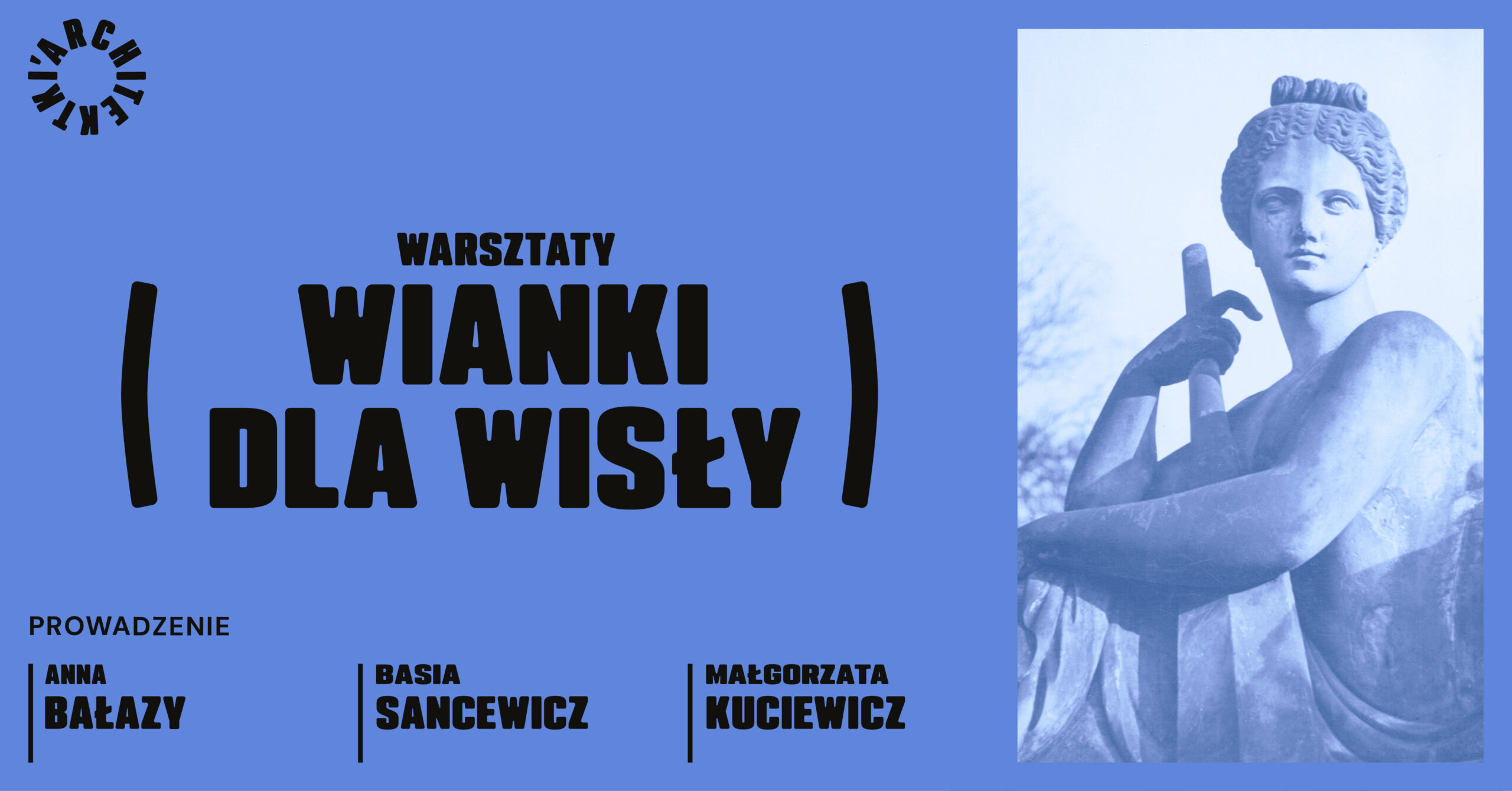
- 12.07.2025 at 11 a.m.
Our relationship with the Vistula has rarely been based on reciprocity. In literature – a queen, a protector, a mother. In reality – a polluted, ailing servant. We draw water, energy, and refreshment from it, and we repay it by dumping sewage or imposing a concrete corset in the form of regulating the riverbed. Is this how we should treat someone who gives us so much?
The wreath is a gesture towards the Vistula, a nod to its subjectivity. It is a small gift to a living being that deserves respect. Woven from aquatic plant seedlings beneficial to its ecosystem, it is not only a symbol but also a practical aid. It is a mutual ritual of closeness. For us, it is a celebration of presence, and for the Vistula, it is recreatio – a chance for renewal.
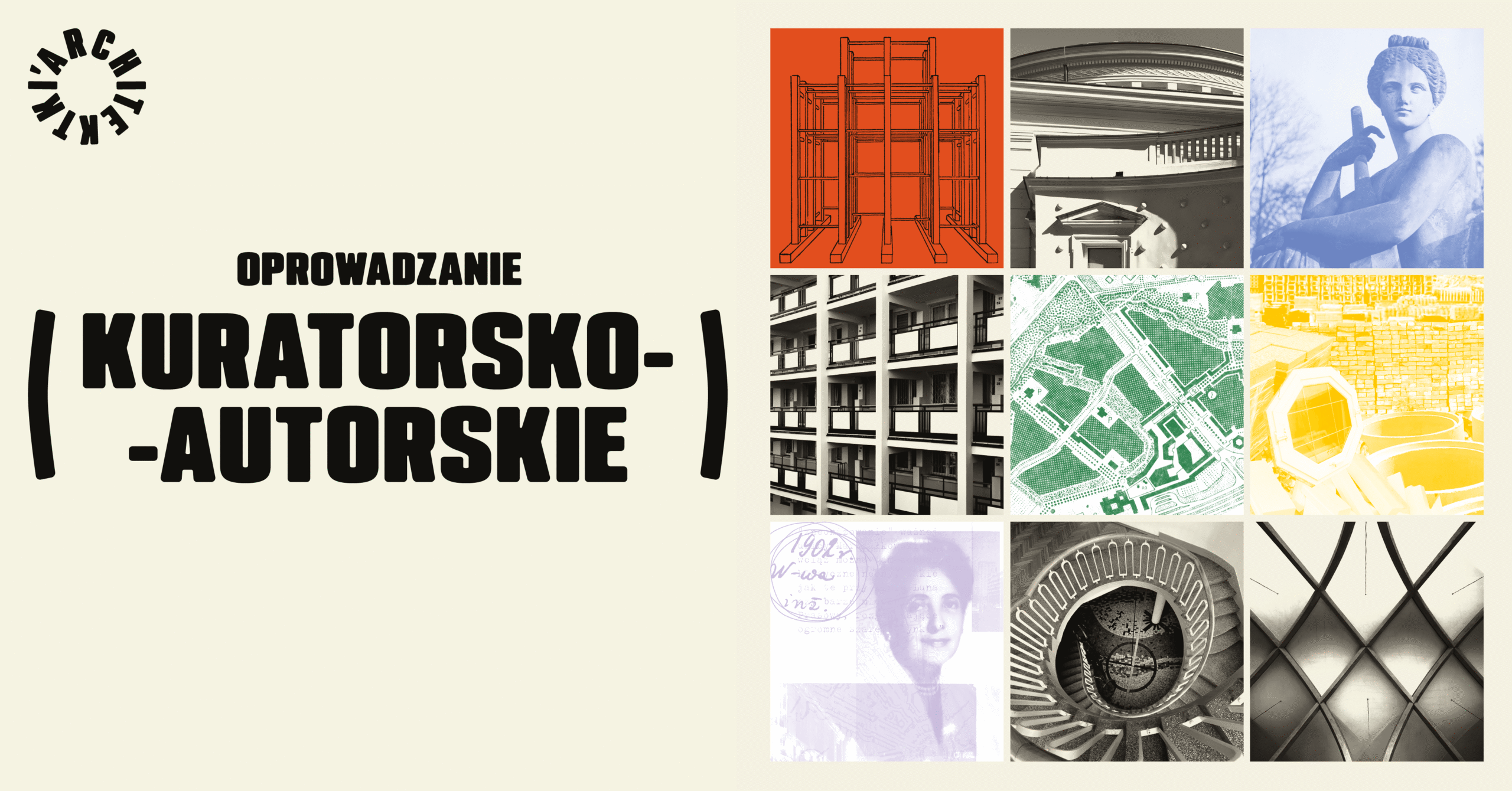
- 20.07.2025 at 4 p.m. – Curator’s and autor’s tour
- 24.08.2025 at 4 p.m. – Curator’s tour
- 18.09.2025 at 10 a.m. – Tour for schools
- 21.09.2025 at 4 p.m. – Curator’s tour
- 25.09.2025 at 10 a.m. – Tour for schools
- 2.10.2025 at 10 a.m. – Tour for schools
- 9.10.2025 at 10 a.m. – Tour for schools
- 16.10.2025 at 10 a.m. – Tour for schools
- 19.10.2025 at 4 p.m. – Curator’s and autor’s tour
The guided tours are a unique opportunity to hear from the authors themselves what inspired them in the work of female architects from previous generations to create their own works shown in the exhibition. In addition, the curators will talk about the idea behind the exhibition and why intergenerational cooperation between female architects is so important.
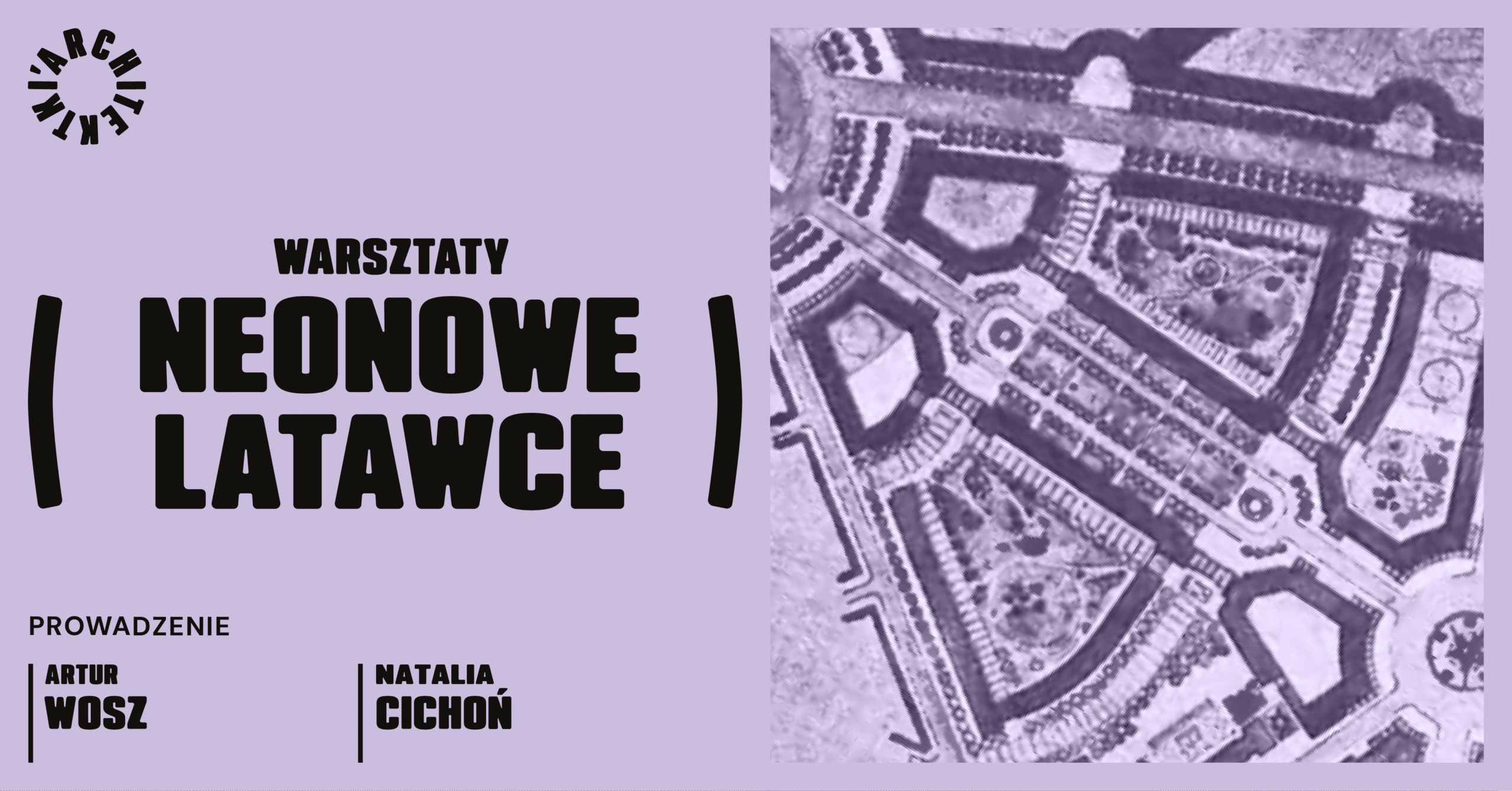
- 3.08.2025 at 12 p.m.
The Latawiec housing estate is Eleonora Sekrecka’s most significant project carried out as part of the reconstruction of the capital. The architecture of the estate takes us to a socialist realist version of Paris’s Place des Vosges. Thanks to the unusual arrangement of the apartment blocks in the shape of a kite, the main avenue of the estate could be filled with trees.
Sekrecka also contributed to giving Warsaw its new, luminous face. When the capital, under the influence of the West, lit up with colorful neon advertisements, she focused on designing urban lighting for the most important streets, including Marszałkowska Street.
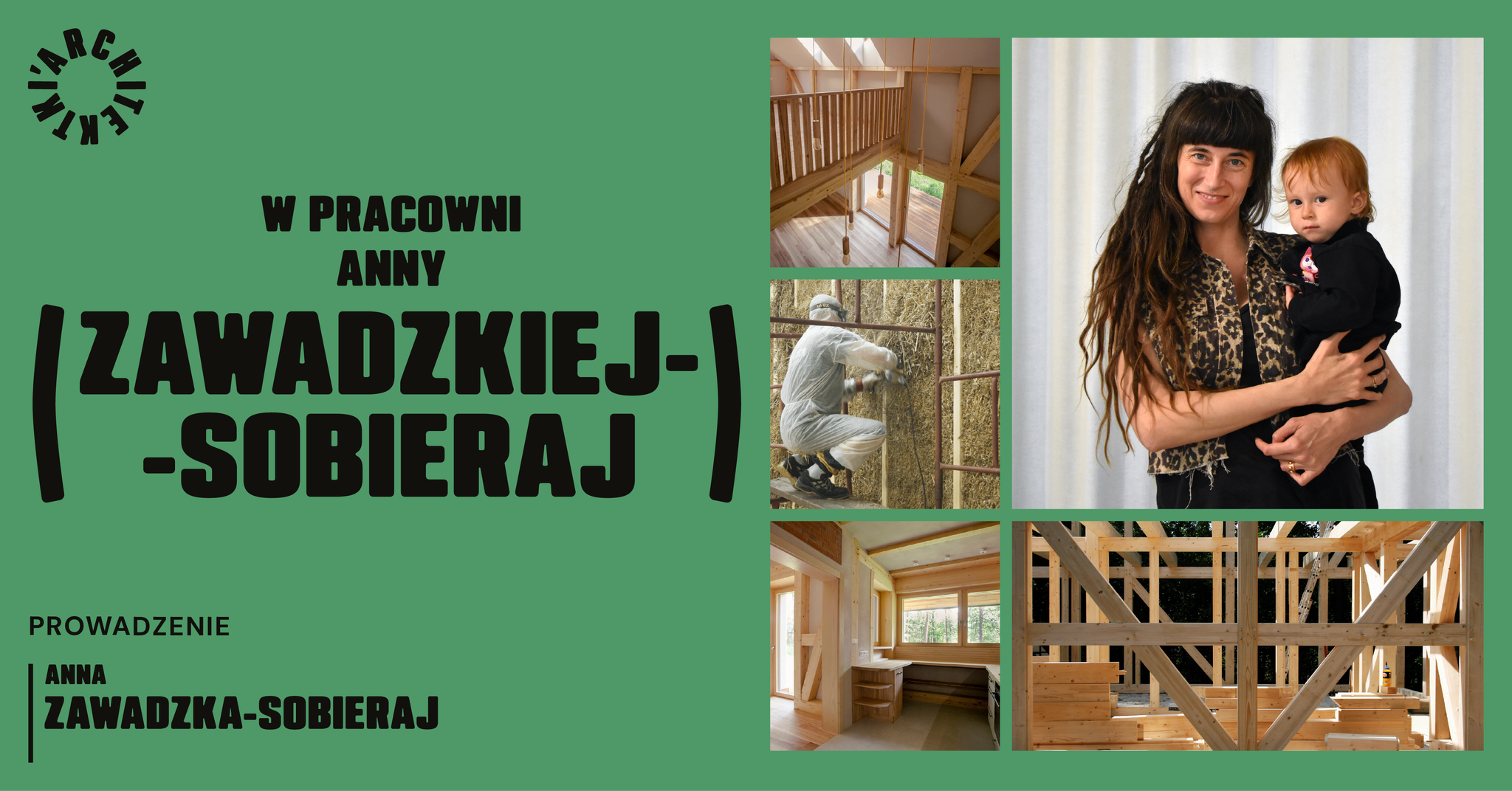
AT THE STUDIO – ANNA ZAWADZKA-SOBIERAJ
- 6.08.2025 at 5:30 p.m.
Ania is an architect, sociologist, and activist. Since 2012, she has been designing buildings and small forms from natural and recycled materials. She also provides environmental consulting services, including audits for the Warsaw Mayor’s Architecture Award. She uses social research in her designs. She collaborates with Materiality in the area of circular economy reports. She is the co-author of the “Decarbonization of Construction Processes” project. She is also active in academia, working on her PhD on circularity in construction and promoting ecology in architecture.
Her studio is a showcase for natural construction and recycling. What’s more, it is located in a modernist tenement house designed by the Syrkus family. Come and visit us!
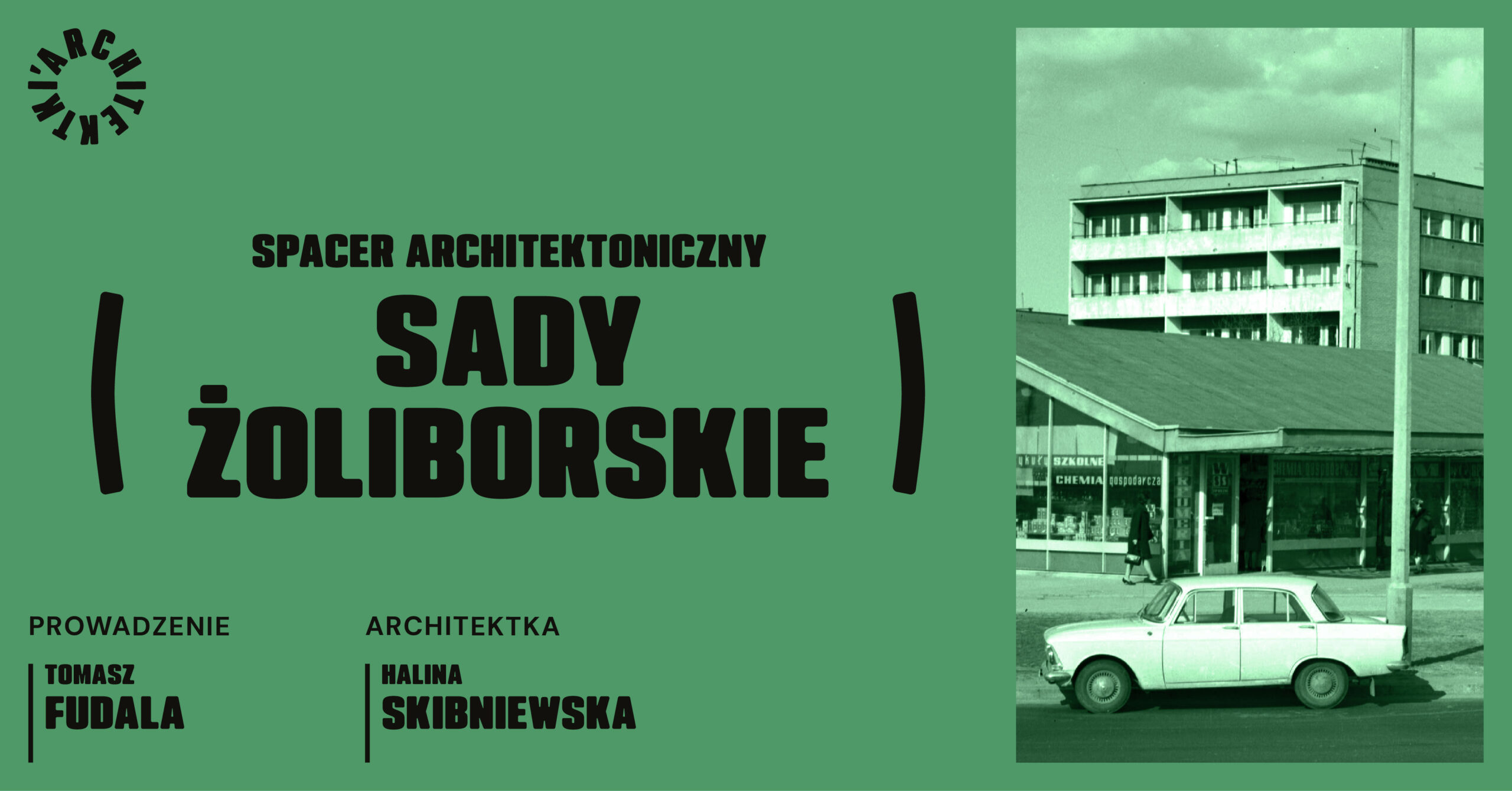
WALK ON SADY ŻOLIBORSKIE WITH TOMASZ FUDALA
- 9.08.2025 at 12 p.m.
Tomasz Fudala invites you to take a walk around Sady Żoliborskie, a housing estate designed mainly by Halina Skibniewska.
Sady Żoliborskie was built between 1958 and 1972. It won the title of Mister and Vice-Mister of Warsaw in a famous competition held in the capital. Skibniewska worked on the design of the housing estate together with Andrzej Kiciński and Andrzej Małek.
Halina Skibniewska (1921–2011) paid particular attention to the social dimension of housing estates in her work. Therefore, in her projects, she cared not only about the functionality of buildings, but also about carefully designed and preserved greenery. She took into account the needs of people with disabilities in her designs. She graduated from the Faculty of Architecture at the Warsaw University of Technology in 1948. Then, from 1971, she was also associated with this university as a lecturer, passing on her knowledge and experience to future generations of architects.
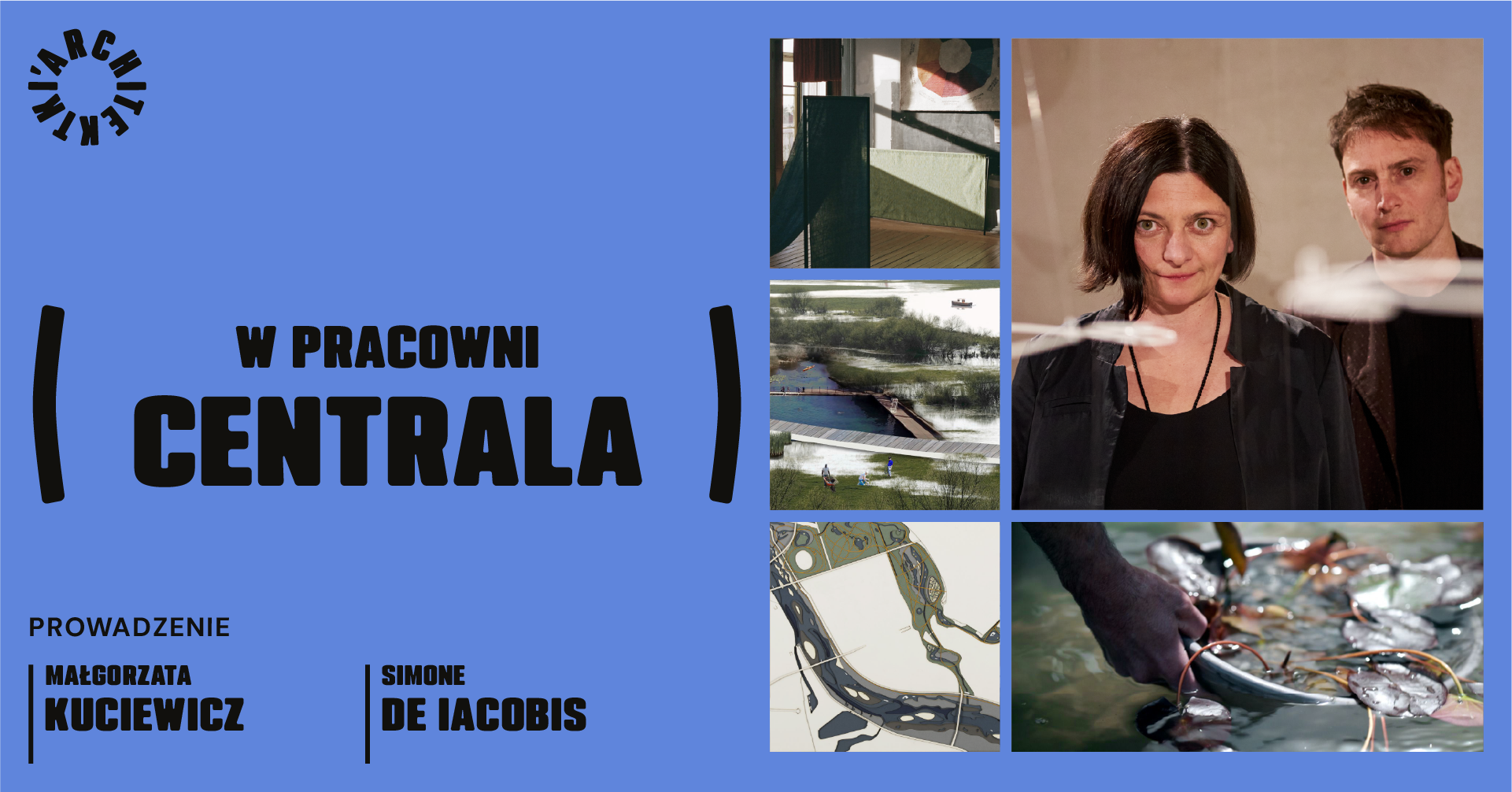
- 12.08.2025 at 17:30 p.m.
The studio is run by Małgorzata Kuciewicz and Simone De Iacobis. They are involved not only in design, but above all in broadening the debate on architecture and inspiring to interdisciplinary activities related to space. Centrala creates projects under the slogan ‘Amplification of Nature’, based on research into the relationship between architecture and natural processes.
They collaborate on an ongoing basis with the Kharkiv School of Architecture, running their own series of workshops. In 2024, together with the Bęc Zmiana Foundation, they published ‘Exercise Books: Light. Water. Wind. Gravity’, encouraging people to go out into the field, immerse themselves in the landscape and make careful observations.

WALK ON KOŁO ESTATE WITH KATARZYNA UCHOWICZ
- 23.08.2025 at 12 p.m.
The Koło estate was built between 1947 and 1951. Here, we find architecture blended into greenery, as well as more or less well-known stories. During the walk, we will follow in the footsteps of architects, a famous painter, the residents themselves, and nature. We will see “Helena’s smile,” fanciful prefabricated concrete elements, and details from the turn of the 1940s and 1950s. The microcosm of the Koło housing estate is still a fascinating and colorful story about creativity, post-war design conditions, and the avant-garde roots of its creators. Helena Syrkus worked on the housing estate together with Szymon Syrkus.
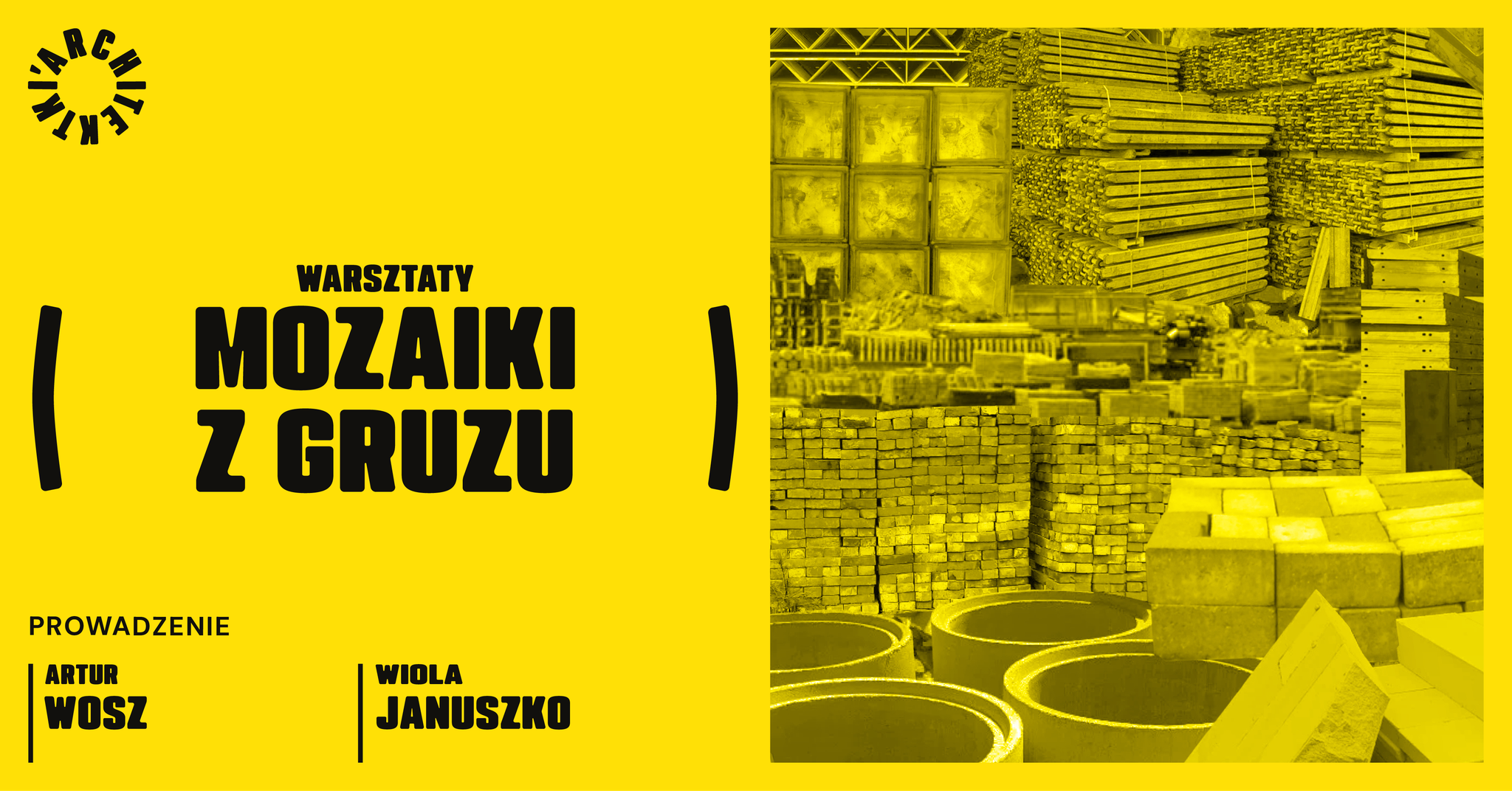
- 24.08.2025 at 12 p.m.
We are demolishing more and more buildings. At the same time, we are not reusing materials from demolished structures. A similar fate befell the Women’s Work Pavilion designed by Anatolia Hryniewicka-Piotrowska. Today, there is no trace of the building, which was intended to be temporary.
During the workshop, we will learn about Hryniewicka-Piotrowska’s work and discuss the reuse of materials in construction.
We will use rubble collected during the reconstruction of the square in front of Zodiak and create mosaics from it.
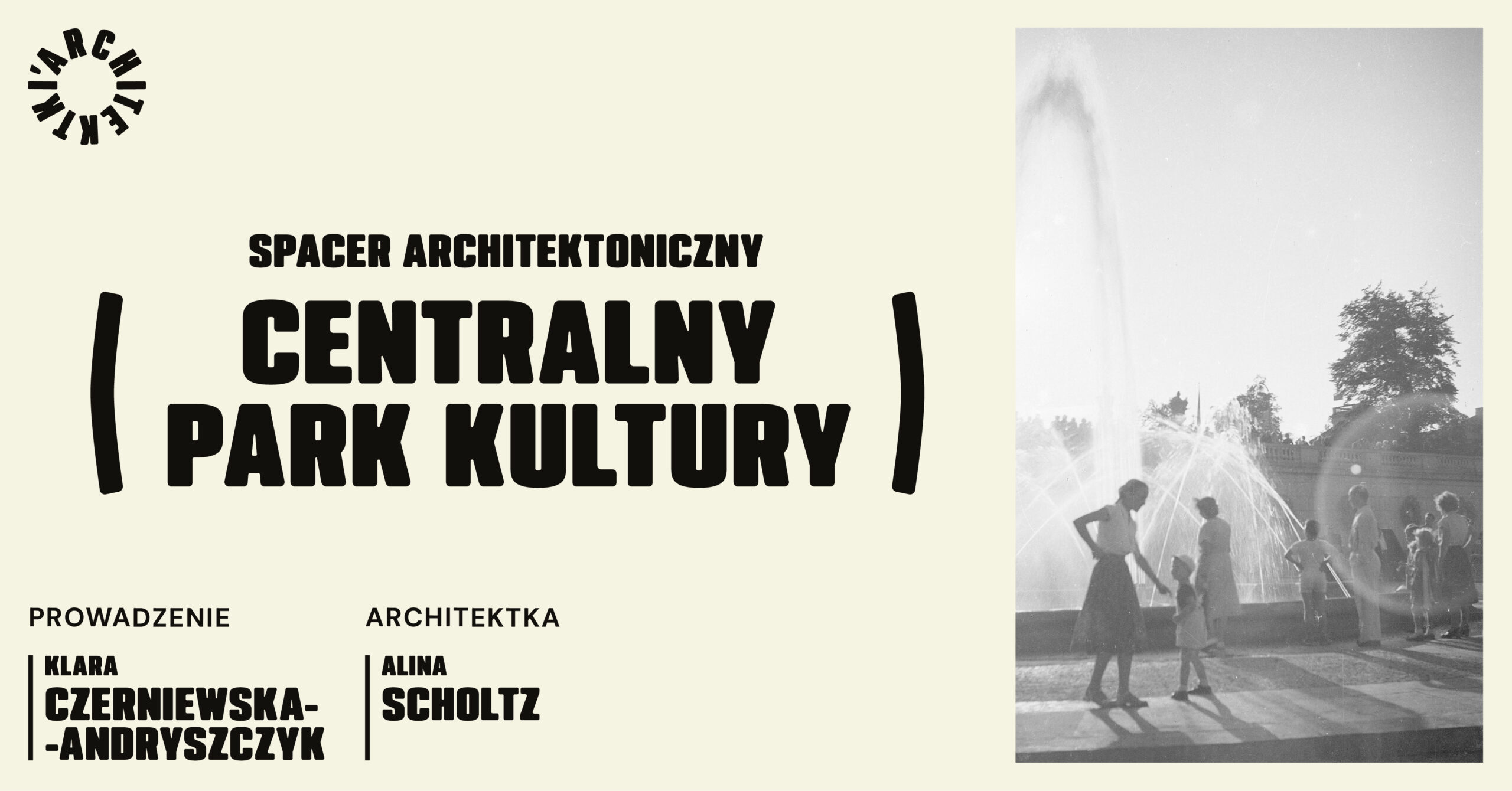
WALK ON CENTRALNY PARK KULTURY WITH KLARA CZERNIEWSKA-ANDRYSZCZYK
- 30.08.2025 at 12 p.m.
The former Central Park of Culture is the green lung of Warsaw – at the time of its creation (1949–1964), it was one of the largest green areas in the capital, supplying the city center with oxygen, greenery, entertainment, and relaxation, and improving the microclimate of the area. In addition, it symbolically and functionally connected the city with the river, and the escarpment above the former riverbed with its present-day course.
Like its contemporary, the Palace of Culture and Science, in terms of its program, it was a socialist realist project, constituting the central point of the complex of so-called culture parks, planned in the Vistula valley from Marymont to Powsin. Its large-scale design was criticized just a few years after its creation. During the walk, we will take a look at the monumental layout and try to identify the completed and preserved elements of architecture, sculpture, and landscape.
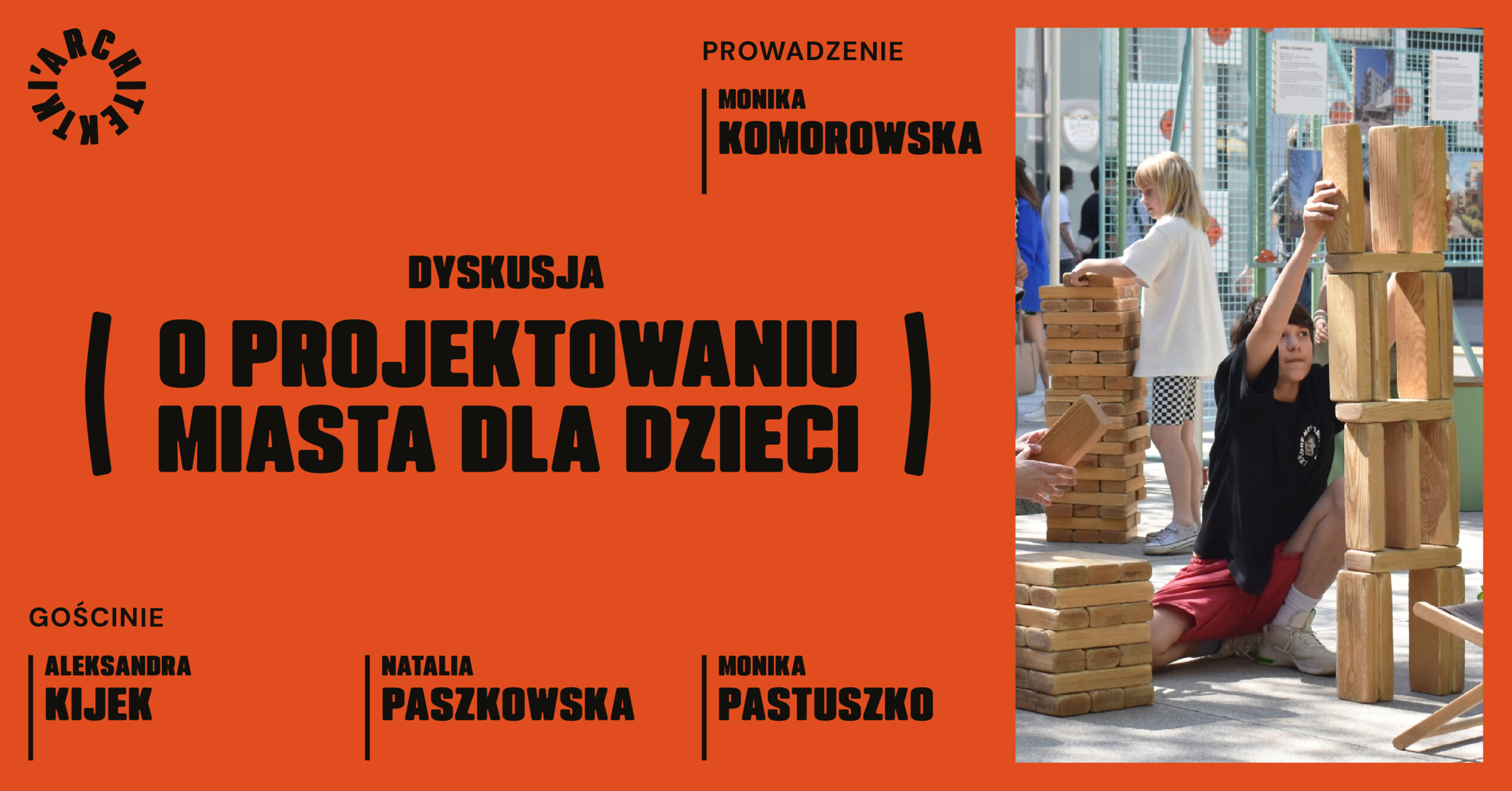
ABOUT DESIGNING CITIES FOR CHILDREN
- 2.09.2025 at 6 p.m.
Are city centers only for adults? How can cities be designed to be friendly to children and their caregivers?
The starting point for the discussion on how to create a child-friendly city will be the work of Nina Jankowska, a pioneer in the design of schools and kindergartens, as well as the surroundings of buildings, which Jankowska considered to be just as important as the buildings themselves. The architect advocated that children should spend as much time as possible outdoors. The forms of Jankowska’s designs were based on in-depth research into children’s ergonomics.
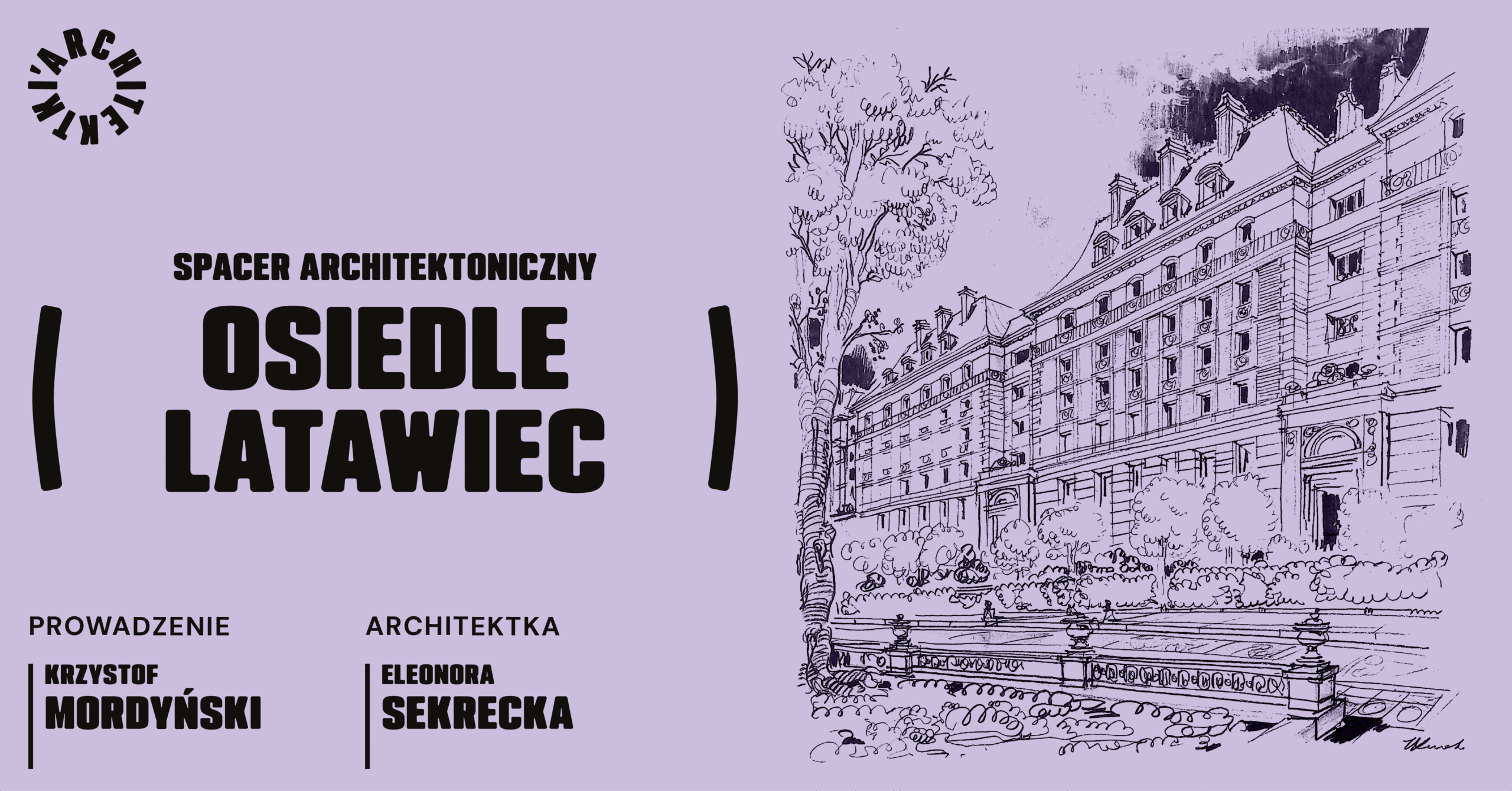
WALK ON LATAWIEC ESTATE WITH KRZYSZTOF MORDYŃSKI
- 6.09.2025 at 12 p.m.
Eleonora Sekrecka was a member of the studio designing the Marszałkowska Residential District from its inception in March 1950. Initially, she headed one of the architectural groups, and then, from 1953, she led the entire studio.
It was between 1953 and 1957 that “Latawiec” estate was created, the greenest part of the MDM, located along Wyzwolenia Avenue. During the walk, we will discover the designer’s architectural and urban inspirations, and we will also walk along the main axis and the backstreets, discover unrealized elements of the complex, and look for interesting details.
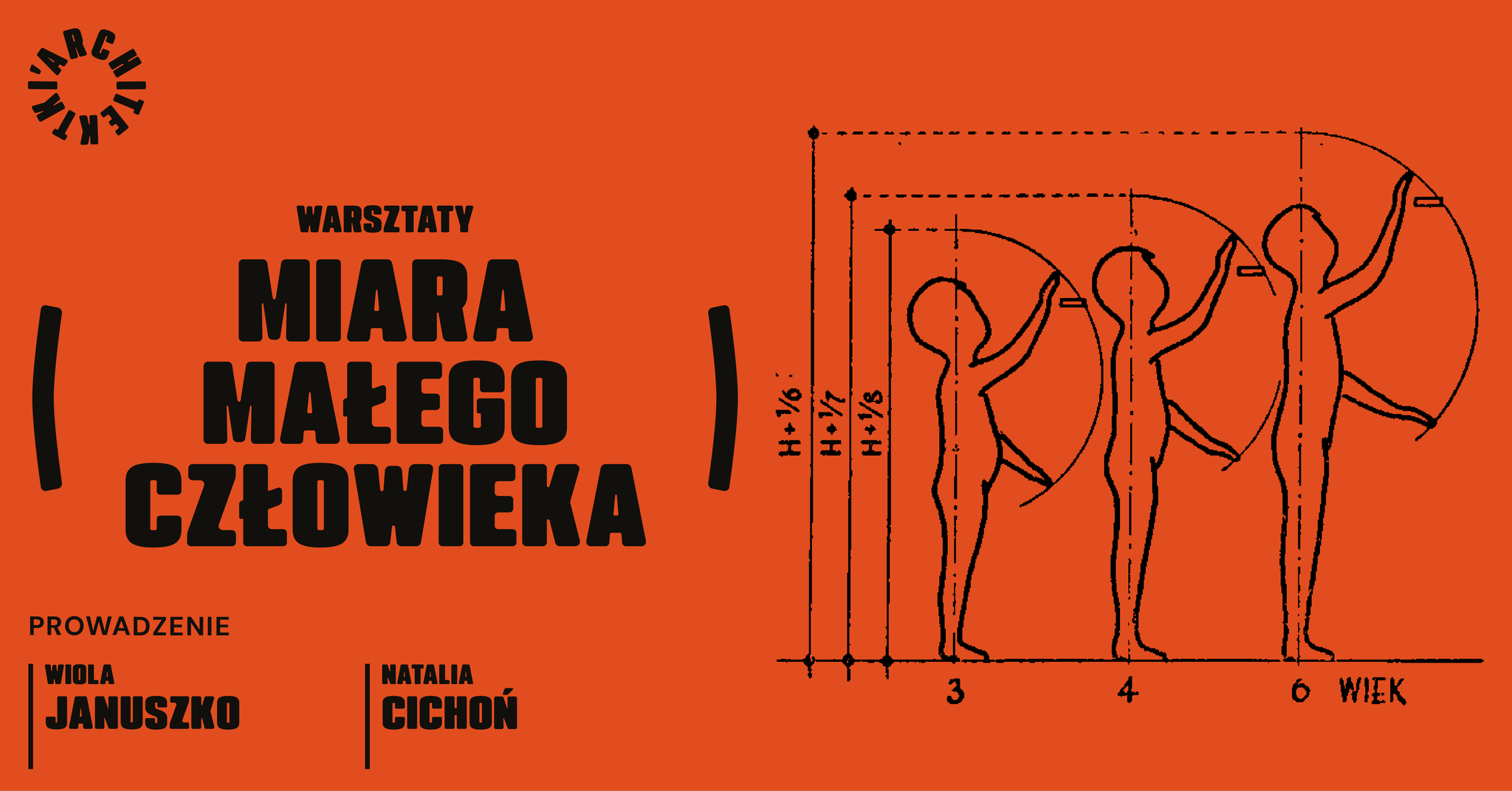
MEASURE OF A LITTLE PERSON | WORKSHOP
- 13.09.2025 at 12:30 p.m.
During the workshop, we will learn about Nina Jankowska, an architect who worked in the interwar period and after World War II. Her designs for children, although anonymous to many, have become an integral part of our everyday lives – she designed, among other things, a sandbox, a balance beam, and a kindergarten cloakroom. She created them using ergonomic research to ensure comfort and safety for the youngest. She collaborated with other specialists to make her designs simple and functional.
What does a desk or chair adapted to children look like? What makes a piece of furniture comfortable? How to design urban space that will meet our individual needs? Let’s find out together by designing and building small furniture and city elements tailored to our needs!



